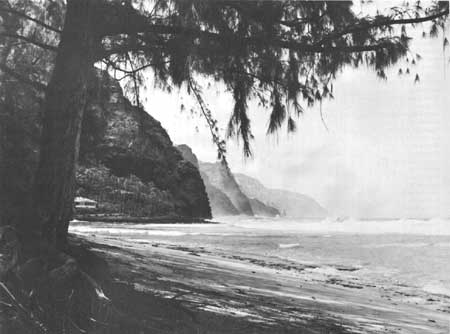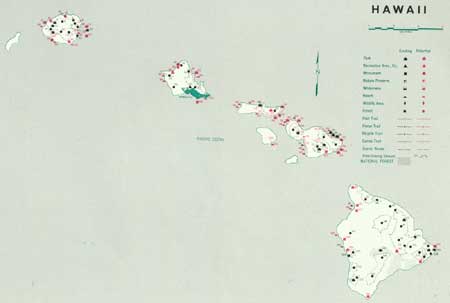.gif)
Parks for America
MENU
|
Parks for America
|

|

|
| Hawaii's Makua Beach on the island of Oahu has been recommended for protection as a State beach area. |
HAWAII
THE Hawaiian Islands, a chain of eight major mid-Pacific islands some 420 miles long and lying about 2,100 miles off the United States mainland, constitute the State of Hawaii.
Hawaii's rapidly growing population rose from 499,794 in 1950 to 632,772 in 1960. By 1976, an estimated 881,000 persons will live on the islands. The population was 76 percent urban in 1960. Average density is 99 per square mile, with a range from 3.5 on the island of Niihau to 837 per square mile on the island of Oahu.
Federal employment and agriculture are important to the economy. The tourist industry now ranks first as a source of income with 1960 expenditures of $131 million. The island of Oahu is the primary visitor target. Undeveloped recreation potential lies on other principal islands.
Access to the islands is by air or ship. Interisland travel is almost exclusively by air.
Hawaii's main recreation resources are spectacular sea and mountain scenery with an equable climate that attracts many recreation visitors the year round and has made the islands a foremost tourist destination.
Interesting shorelines and superb beaches are basic to the tourist industry and a preponderant resource for an expanding urban population. Active volcanoes are of national significance. Sea sport fisheries and hunting present extensive appeal. The State holds forest reserves of over a million acres that have a diverse animal and bird life. Widely scattered and colorful historic features assume national significance. The persistence of the colorful charm of early Hawaiian customs is a noteworthy and appealing resource. The Bishop Museum and the University of Hawaii are most active in preserving the Polynesian culture and archeological evidences of the past. There is active local interest also in Hawaii's rich heritage.
EXISTING PUBLIC AREAS
NATIONAL: The National Park Service administers two national parks and one national historical park totaling 196,222 acres. The 1960 attendance was 836,000. The Bureau of Sport Fisheries and Wildlife has one national wildlife refuge of some 4,000 acres administered by the State Division of Fish and Game.
STATE: Under the Division of State Parks are 17 areas amounting to 6,157 acres and having a 1960-61 attendance of 296,828. The Division of Fish and Game manages 416,000 acres in 21 game management areas and 417 acres in 3 fishing areas. The Division of Forestry administers 47 areas amounting to 981,000 acres and including extensive private watershed areas. There is minimal facility development in these areas. Forest reserves on military reservations or otherwise not open to the public are not included. The State owns a number of important historic buildings. The need to preserve and interpret them is recognized.
LOCAL: There are 1,618 acres in 24 nonurban beach parks serving Honolulu. Elsewhere there are four local areas totaling 1,189 acres.
PRIVATE ENTERPRISE: Private enterprise plays a major role in the recreation picture by providing extensive resort developments for out-of-State visitors.
PARK AND RELATED NEEDS
There is need for protection of parks and natural areas to attract and hold tourists and to serve residents of the State. Additional public recreation areas and facilities are needed, the most urgent need being public beaches for the Honolulu metropolitan area. Special attention should be given to such recreation categories as foot trails and overnight campsite development and to the expansion of recreation outlets for the local population. Designation and adequate protection of scenic roads would be of great value to out-of-State visitors and the local population. Historic sites need State protection, and additional reserves should be identified and created.
Potential acreage of State significance identified in this plan amounts to 22,807 acres.
Further study of potential local recreation areas is needed.

|
| Kauai's Na Pali Coast, with 200-foot sea cliffs, is part of superb natural area being studied for possible national park status. |
RECOMMENDATIONS
Existing recreation resources and many potential areas are shown on the accompanying tabulation and map. The following recommendations are offered to help provide needed outdoor recreation opportunities for public enjoyment and use.
NATIONAL: Further study of the Na Pali-Barking Sands area.
Additional studies are also needed regarding the future of the Russian Fort-Waimea Beach and Iolani Palace.
STATE: Expansion of the State park system by the addition of 9 parks, 1 recreation area, 1 historic site, and 9 beaches, with further study of 7 parks, 10 historic sites, and 13 beaches. Designate and protect 13 scenic routes and 1 free-flowing stream.
Supporting recommendations include—
1. Provision for a suitable wayside system to increase both resident and visitor driving enjoyment.
2. Serious consideration of extensive wilderness reserves on Kauai and Molokai to determine their significance.
3. Examination of the recreation potential and construction feasibility of fresh-water impoundments.
(Table omitted from online edition)

|
| (click on image for an enlargement in a new window) |
NEXT >>>
|
|
Last Modified: Mon, Sep 6 2004 10:00:00 pm PDT
parks_america/hawaii.htm
 Top
Top